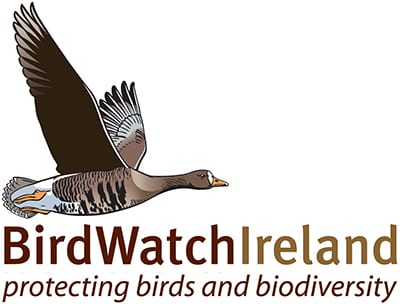Giolla Brighde, meaning the ‘Servant of St. Brigid’, is one of the names for the Oystercatcher in Irish. The story goes that St. Brigid was pursued by a band of men who wished to kill her. Coming onto a beach she realized there was nowhere to hide and so praying, lay down on the beach, accepting her fate. A flock of Oystercatchers was nearby. Realising what was happening, they quickly gathered seaweed and covered St. Brigid, hiding her from the men. In return for saving her, St. Brigid blessed the Oystercatcher. Since then, the Oystercatcher has been linked to Ireland’s principal female saint.
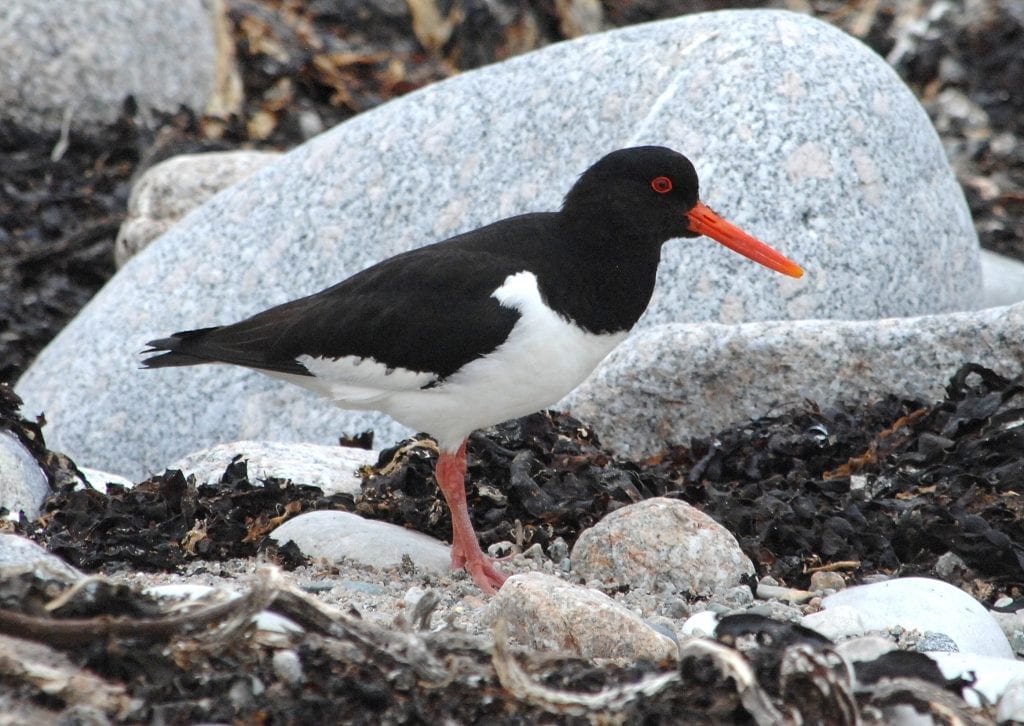 Oystercatcher on seashore. (Michael Bell).
Oystercatcher on seashore. (Michael Bell).
It’s fitting therefore, that on the 2nd of February, the day after St. Brigid’s Day, the Dublin Bay Birds Project caught and colour ringed over 220 Oystercatchers at Sandymount Strand in Dublin Bay. The 2nd of February is also World Wetlands Day, a chance to celebrate and recognize these important habitats. And what better way to do that, than by working to better understand and thus protect St. Brigid’s Bird.
 Oystercatcher. (Thomas McDonnell).
Oystercatcher. (Thomas McDonnell).
The Oystercatchers were caught under license using a highly specialized technique called cannon netting. Essentially, nets attached to projectiles or ‘cannons’ are fired over flocks. This requires an enormous amount of skill and training, and once again we had the cannon netter extraordinaire, Ewan Weston of the Highland and Grampian Ringing Groups in Scotland, cannon-netting on our behalf. To read more about previous catches see here and here.
 Ewan Weston, centre left, fitting a tracking device to a Curlew at Bull Island, South Lagoon, 2016 for the Dublin Bay Birds Project. (Brian Burke).
Ewan Weston, centre left, fitting a tracking device to a Curlew at Bull Island, South Lagoon, 2016 for the Dublin Bay Birds Project. (Brian Burke).
In the days leading up to the catch, recces were carried out so we could build up a picture of where within the bay the birds were roosting (resting) on a rising and high tide. The exact location of these roost sites can change to a remarkable degree between dates, depending on variables like tide heights, weather, and disturbance. However, by watching the flocks over a few days, their choice of location on the day can be more easily predicted.
 Oystercatcher roost forming on Sandymount Strand, Dublin Bay. (Ewan Weston).
Oystercatcher roost forming on Sandymount Strand, Dublin Bay. (Ewan Weston).
The day before the catch, we were once more on Sandymount Strand, watching the birds from a distance. Once the tide began to recede and the birds had moved onto the sandflats, we went out to the roost, searching for the high tide line and signs pinpointing where the birds had been (footprints, feathers, and droppings). We then marked the extent of the roost site. The next day, we set the nets before high tide at this spot.
 Setting up the cannon nets. (Brian Burke).
Setting up the cannon nets. (Brian Burke).
After the nets were set, Ewan retreated to a hide, watching for the perfect moment to fire the cannons as the roost formed in front of the nets. The rest of us hid from view behind the marram grass, waiting for his signal. Eventually, the walkie-talkie crackled into life. We heard the count-down, ‘3,2,1’, a bang as the cannons fired, and we were off!
 Ewan’s view from the hide overlooking the Oystercatcher roost. (Ewan Weston).
Ewan’s view from the hide overlooking the Oystercatcher roost. (Ewan Weston).
Some of us ran to the nets, pushing them up and away from the tideline, before quickly but carefully taking the birds out. Others rushed to set up the storage or keep crates where the birds would be safely kept until they could be ringed and released. Runners raced about, ferrying birds to the keep crates. Everyone had their role and thus, amid this seeming chaos, organisation reigned.
 Removing the birds from nets and ferrying them to the keep crates. (Helen Boland).
Removing the birds from nets and ferrying them to the keep crates. (Helen Boland).
 Oystercatchers in the keep crates where they are kept calm until they can be ringed. (Barry O’Mahony).
Oystercatchers in the keep crates where they are kept calm until they can be ringed. (Barry O’Mahony).
Once the birds were all safely tucked away, and the ringing stations had been assembled, we got to work, taking biometrics (wing and bill lengths, and weight), aging the birds, and fitting them with BTO metal rings and colour rings.
 ‘Oystercatcher ringing station’. (Sarah Hegarty).
‘Oystercatcher ringing station’. (Sarah Hegarty).
 Eye colour is diagnostic of age. Red eye – adult (forefront), brown eye – immature bird (back). (Helen Boland)
Eye colour is diagnostic of age. Red eye – adult (forefront), brown eye – immature bird (back). (Helen Boland)
Bill and wing length can be used to determine whether the bird is male or female, although this can be tricky as particularly with wing length there is some overlap between the sexes. Weight can be used to infer the health of an individual bird. When enough birds are caught, to an extent we can use these weights to infer the health of the local population.
Colour rings have unique codes which enable us to individually identify each bird. For this catch we used a white flag on the right tibia (upper leg) and a blue, uninscribed ring on the left tibia. Thanks to Kendrew Colhoun for allowing us to make use of his ringing scheme on the day.
 Measuring wing length. Colour combination: white flag – right tibia (upper leg), uninscribed blue ring – left tibia. (Sarah Hegarty).
Measuring wing length. Colour combination: white flag – right tibia (upper leg), uninscribed blue ring – left tibia. (Sarah Hegarty).
This work allows us to gather data or information on how colour ringed birds use Dublin Bay for foraging and roosting and their reliance on key sites for these activities. It also enables us to examine their dependence on grassland sites surrounding the bay, a really important aspect given development, recreational, and climate change pressures on wetland habitats. These ring resightings also provide information about population exchange between wetland sites, migratory routes, and breeding locations.
 Oystercatcher ‘NVP’ ringed at Sandymount Strand on the 2nd of February and spotted on a playing pitch in Donnybrook on the 16th of February 2022. (John Fox).
Oystercatcher ‘NVP’ ringed at Sandymount Strand on the 2nd of February and spotted on a playing pitch in Donnybrook on the 16th of February 2022. (John Fox).
Some birds have been spotted frequently, like Oystercatcher ‘J9’ who has been spotted >50 times since it was ringed in November 2016. This bird is remarkably site faithful, with >40 of its resightings at Bull Islands, South Lagoon. So, we know that ‘J9’ is heavily reliant on the South Lagoon for foraging and roosting.
Other birds can fall off the grid, sometimes for years, before being spotted once more, alive, and well. Take ‘F0’ for example. Ringed as part of the same catch as ‘J9’ in November 2016, it was last seen in Dublin Bay on the 24th of January 2017, before popping back up in Dundalk Bay in February this year (spotted by Tom Cooney and Peter Knight). Whether ‘F0’ has been flying under our radar in Dublin or Dundalk Bay, or perhaps one of the other wetlands between the two sites is unclear.
 Oystercatcher in flight. (Kevin Murphy).
Oystercatcher in flight. (Kevin Murphy).
However, what this and other resightings of Oystercatchers in Dundalk Bay prove is that is that population exchange is occurring between Oystercatchers in Dublin Bay and Dundalk Bay. This may have been guessed at before, but it was never proven until recent years. And why does this matter? Having a network of protected wetland sites which these birds can depend upon protects the overall population. In the face of mounting pressures, understanding these movements is critical to safeguarding these populations.
As I write, the majority of Oystercatchers which over-winter in Dublin Bay will have left for the breeding grounds. Through colour ringing efforts we now know there are strong links between Oystercatchers over-wintering in Dublin Bay and breeding in Scotland and Iceland. There is still so much to be learned about wading bird populations in Ireland, and colour ringing is enabling us to better understand their ecology, and in so doing, better protect these species.
 Oystercatcher ‘JU’ on the Isle of Bute, Scotland in April 2019. (Ian Hopkins).
Oystercatcher ‘JU’ on the Isle of Bute, Scotland in April 2019. (Ian Hopkins).
 Oystercatcher ’04’ at Engjabakki, Eskifjörður, Iceland in March 2021. (Baldwin Baldwinsson).
Oystercatcher ’04’ at Engjabakki, Eskifjörður, Iceland in March 2021. (Baldwin Baldwinsson).
Not all Oystercatchers will leave our shores this season, with immature birds remaining behind on our shores. Some of these will have been ringed. If you see these or any other colour ringed birds, you can submit your resightings here or email colourrings@birdwatchireland.ie. If you see a white flagged bird, recording the colour of the uninscribed ring as well as the code is critical – this can be red or blue.
 Oystercatcher ‘NVP’. Note the blue uninscribed ring on the left tibia (upper leg). (John Fox).
Oystercatcher ‘NVP’. Note the blue uninscribed ring on the left tibia (upper leg). (John Fox).
A massive thanks to all of the amazing people who helped us out at the catch, to Kendrew Colhoun who provided logistical support and equipment, to Ewan Weston for his expertise, and to the fantastic ring readers who make this work worthwhile! And a huge thanks as always to Dublin Port Company, for funding and supporting this work!

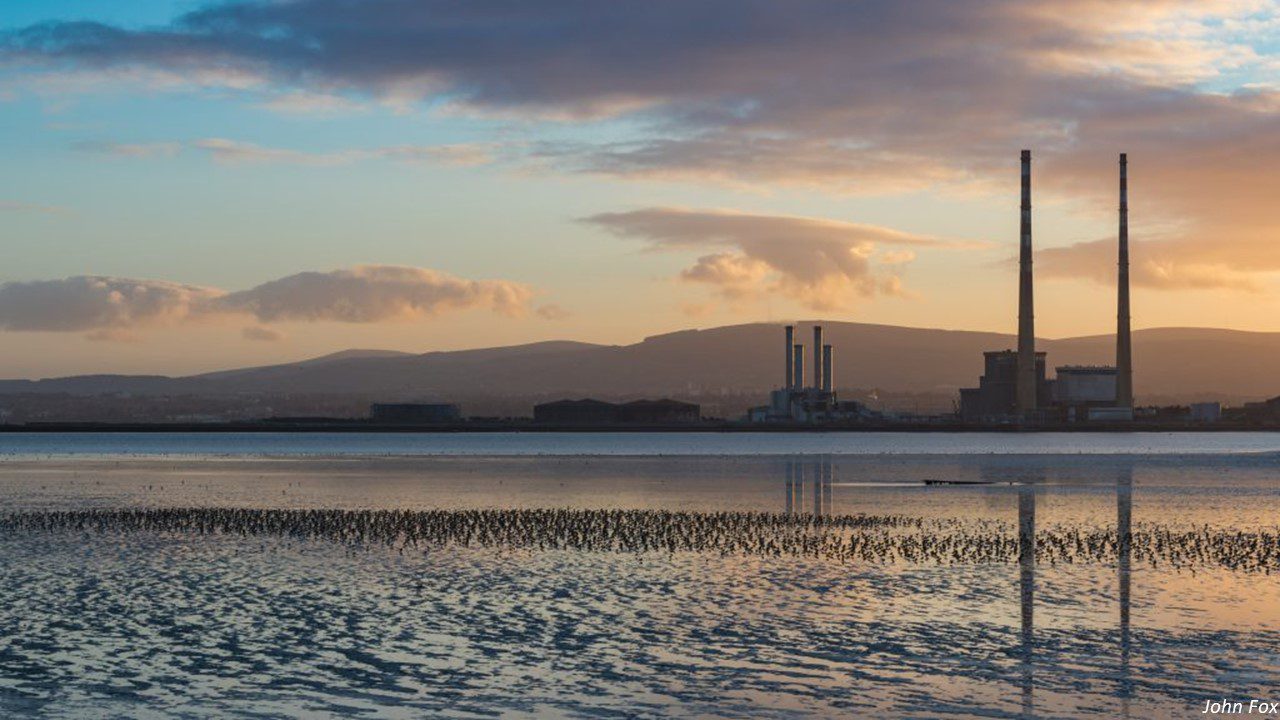
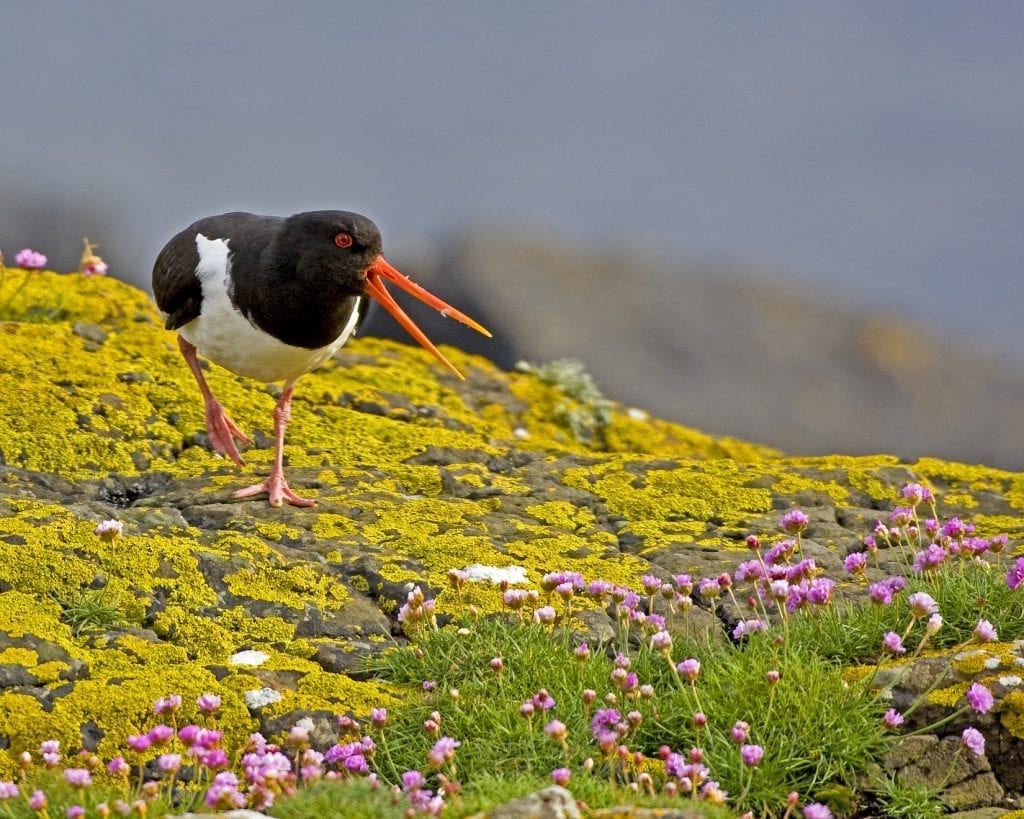 Oystercatcher. (Thomas McDonnell).
Oystercatcher. (Thomas McDonnell).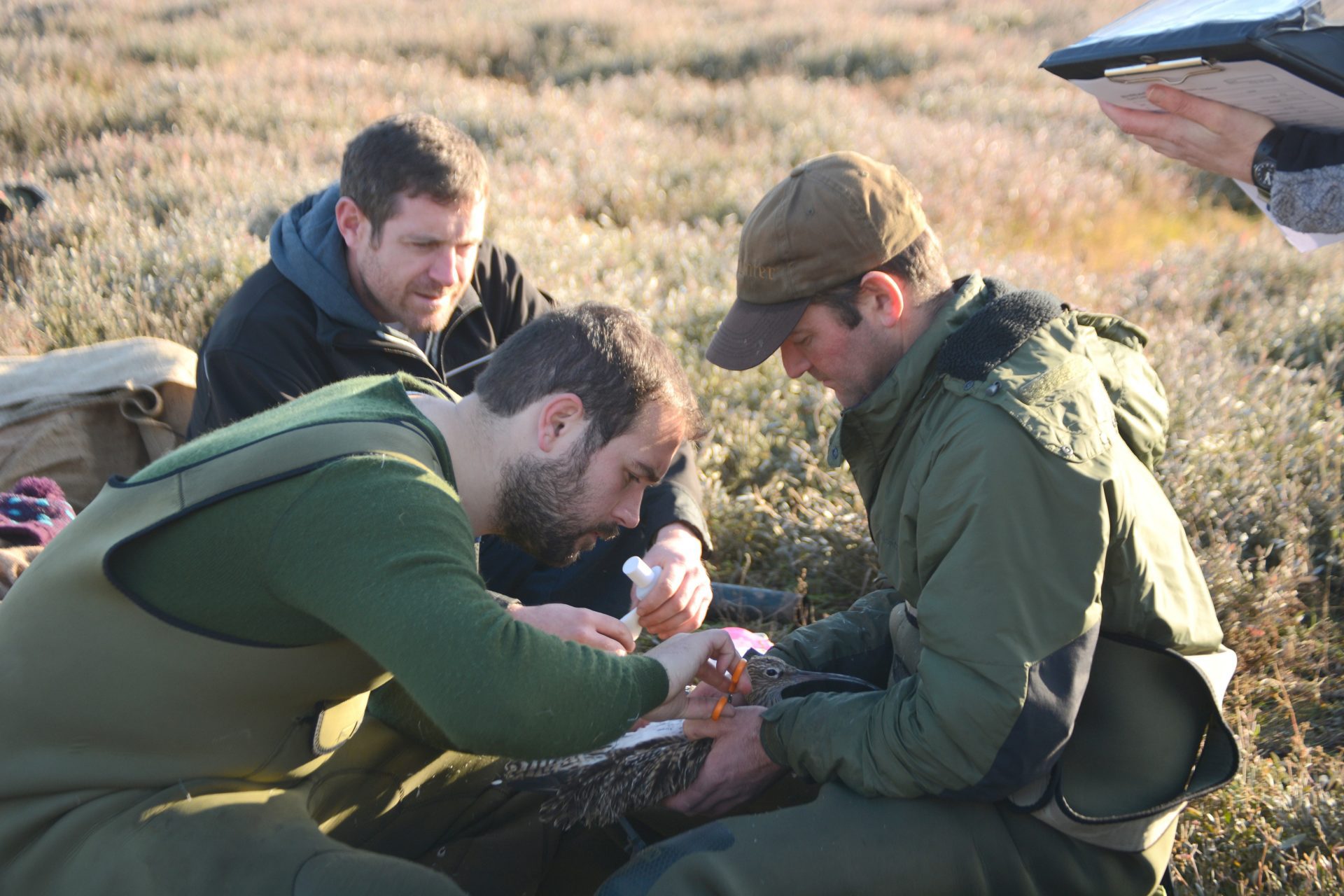 Ewan Weston, centre left, fitting a tracking device to a Curlew at Bull Island, South Lagoon, 2016 for the Dublin Bay Birds Project. (Brian Burke).
Ewan Weston, centre left, fitting a tracking device to a Curlew at Bull Island, South Lagoon, 2016 for the Dublin Bay Birds Project. (Brian Burke).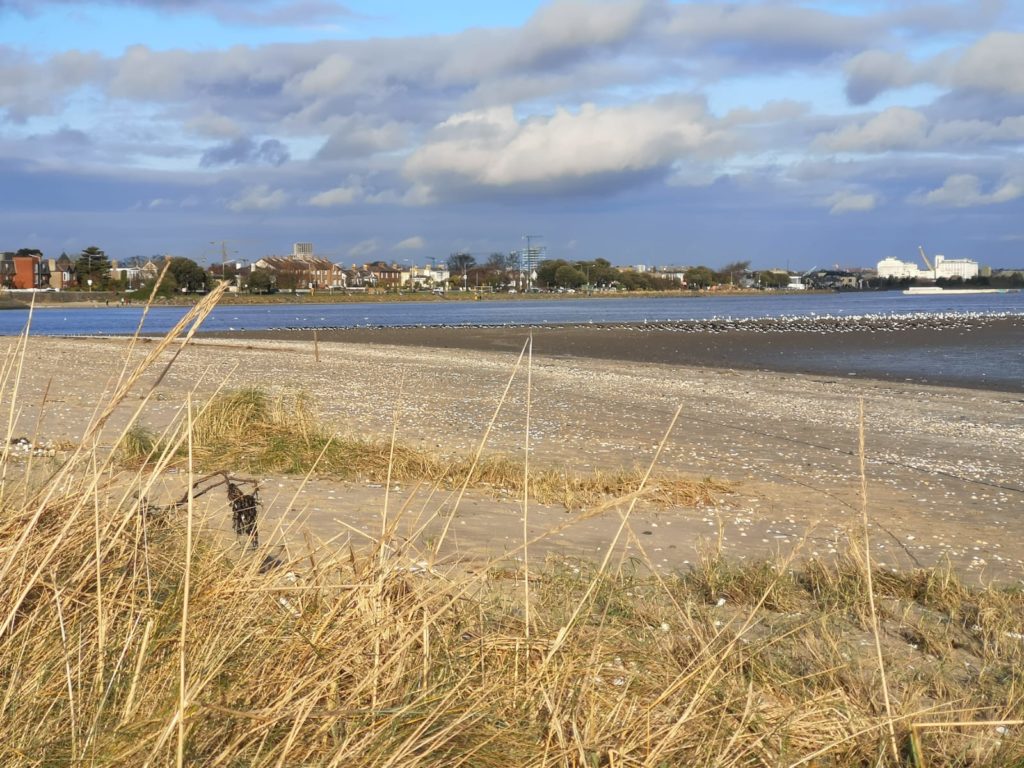 Oystercatcher roost forming on Sandymount Strand, Dublin Bay. (Ewan Weston).
Oystercatcher roost forming on Sandymount Strand, Dublin Bay. (Ewan Weston).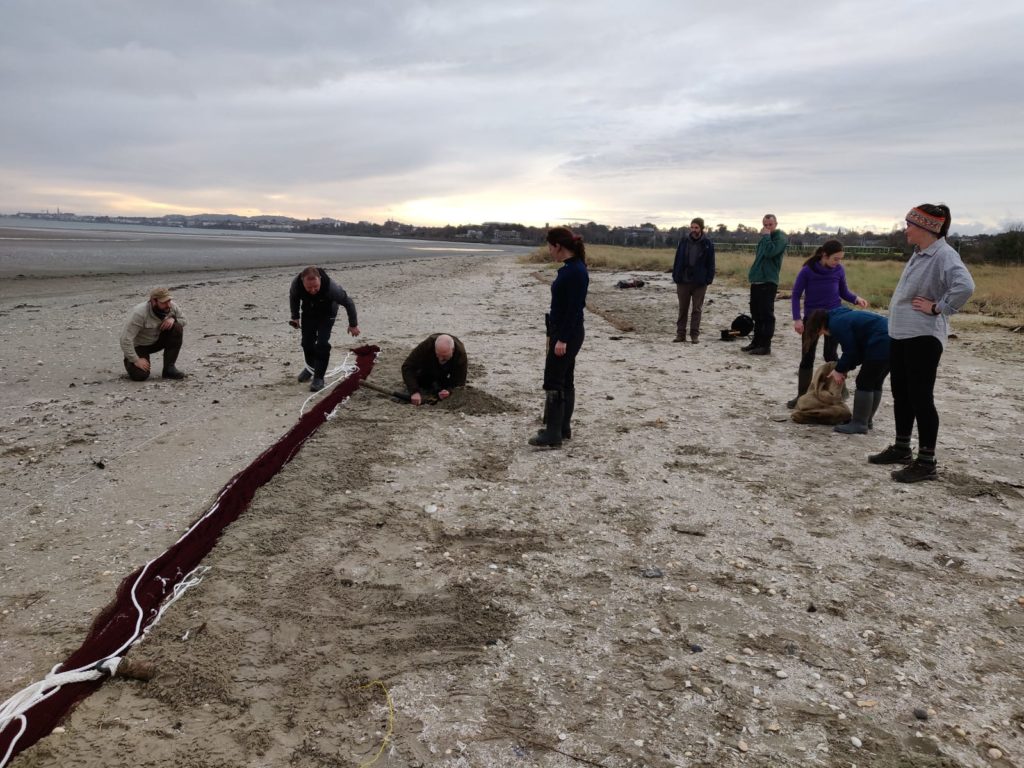 Setting up the cannon nets. (Brian Burke).
Setting up the cannon nets. (Brian Burke).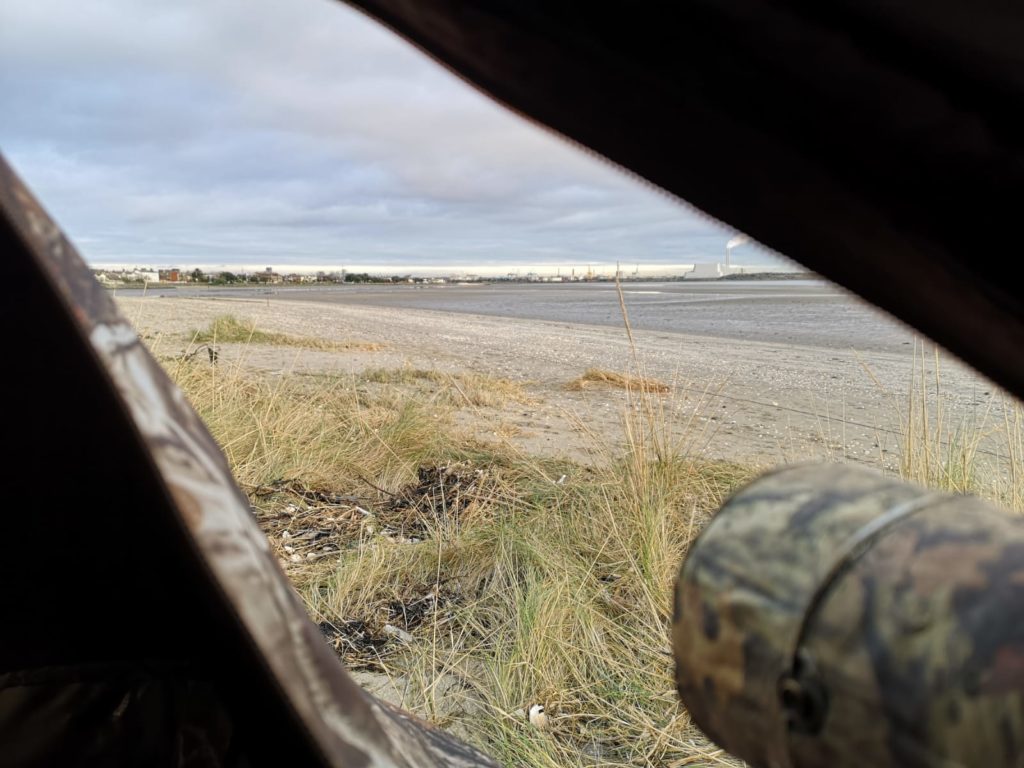 Ewan’s view from the hide overlooking the Oystercatcher roost. (Ewan Weston).
Ewan’s view from the hide overlooking the Oystercatcher roost. (Ewan Weston).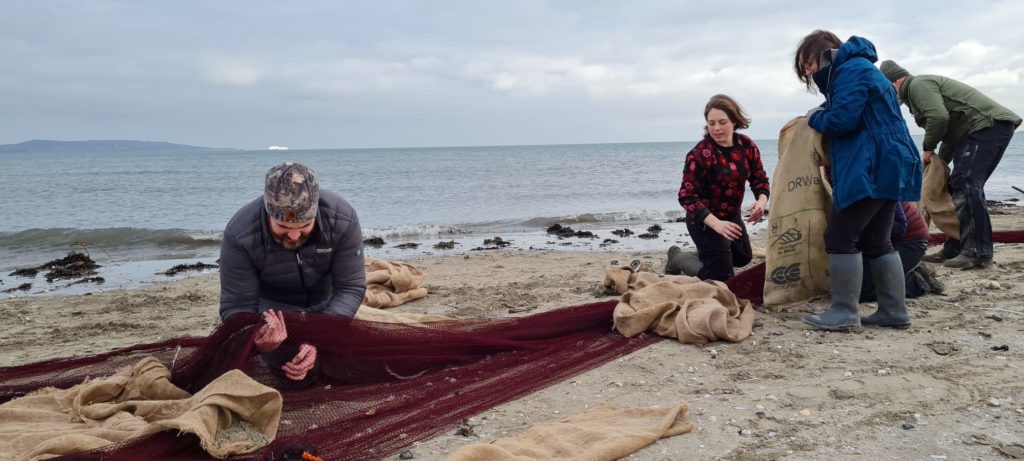 Removing the birds from nets and ferrying them to the keep crates. (Helen Boland).
Removing the birds from nets and ferrying them to the keep crates. (Helen Boland).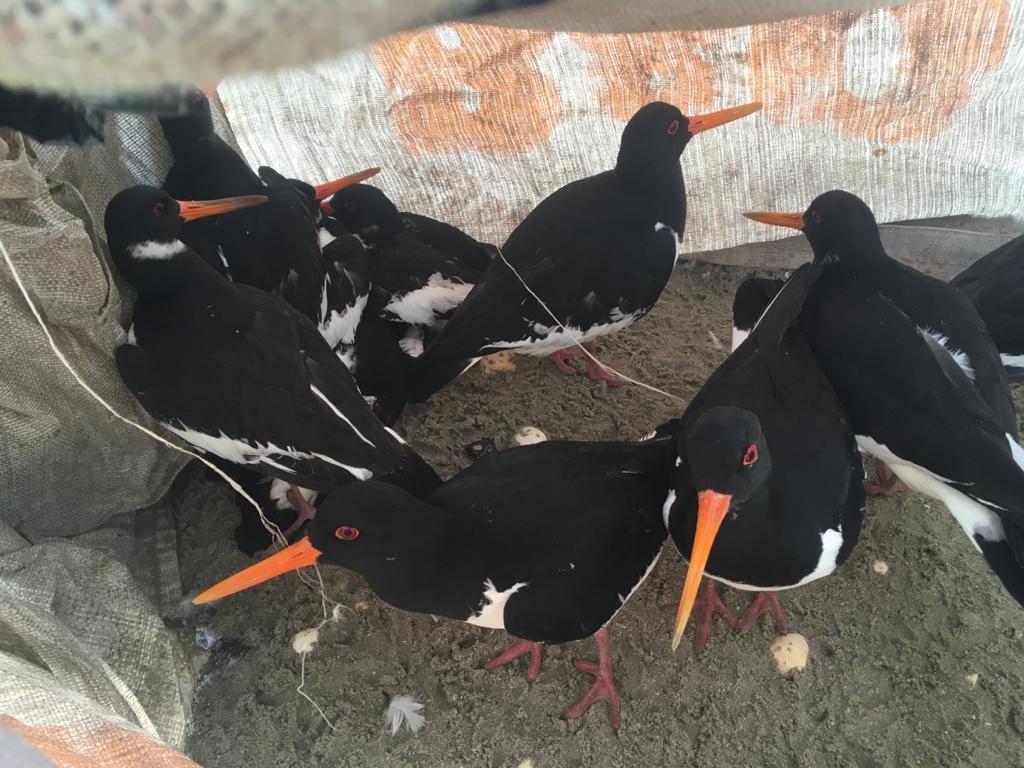 Oystercatchers in the keep crates where they are kept calm until they can be ringed. (Barry O’Mahony).
Oystercatchers in the keep crates where they are kept calm until they can be ringed. (Barry O’Mahony).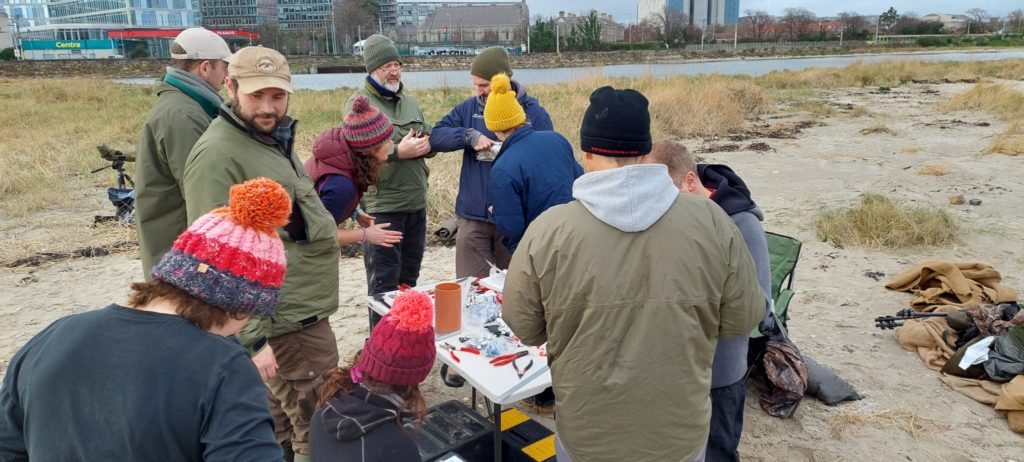 ‘Oystercatcher ringing station’. (Sarah Hegarty).
‘Oystercatcher ringing station’. (Sarah Hegarty).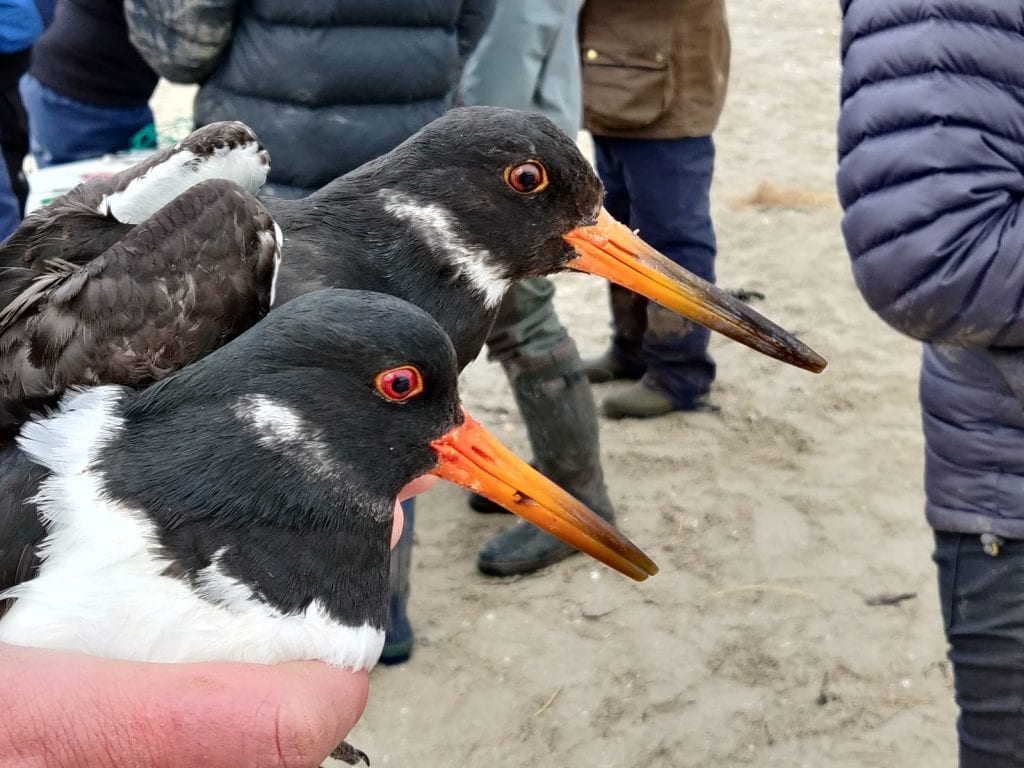 Eye colour is diagnostic of age. Red eye – adult (forefront), brown eye – immature bird (back). (Helen Boland)
Eye colour is diagnostic of age. Red eye – adult (forefront), brown eye – immature bird (back). (Helen Boland)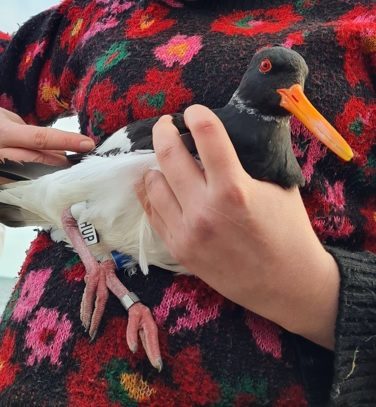 Measuring wing length. Colour combination: white flag – right tibia (upper leg), uninscribed blue ring – left tibia. (Sarah Hegarty).
Measuring wing length. Colour combination: white flag – right tibia (upper leg), uninscribed blue ring – left tibia. (Sarah Hegarty).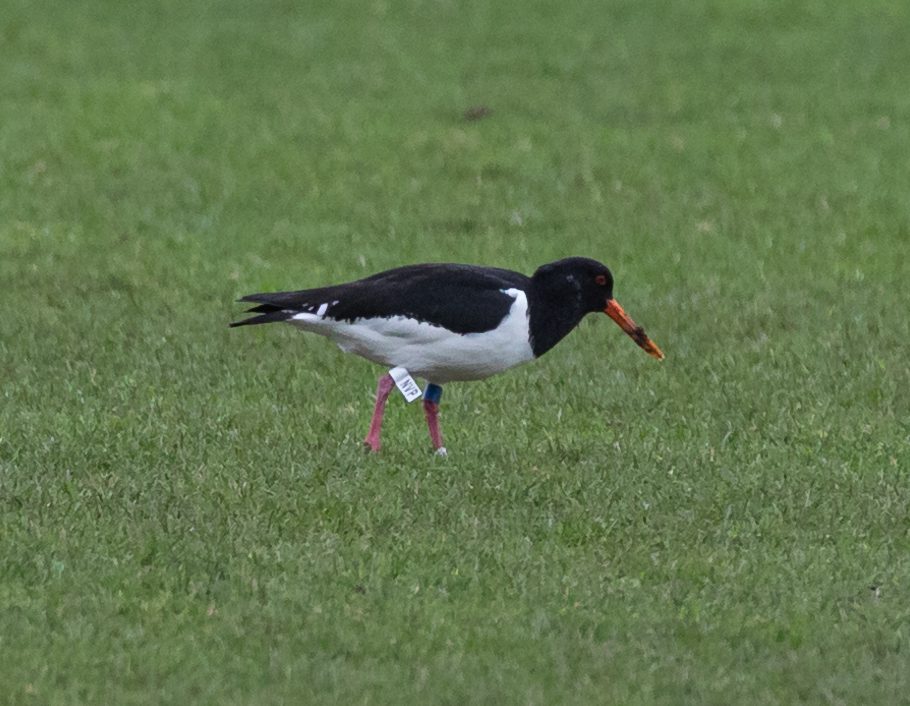 Oystercatcher ‘NVP’ ringed at Sandymount Strand on the 2nd of February and spotted on a playing pitch in Donnybrook on the 16th of February 2022. (John Fox).
Oystercatcher ‘NVP’ ringed at Sandymount Strand on the 2nd of February and spotted on a playing pitch in Donnybrook on the 16th of February 2022. (John Fox).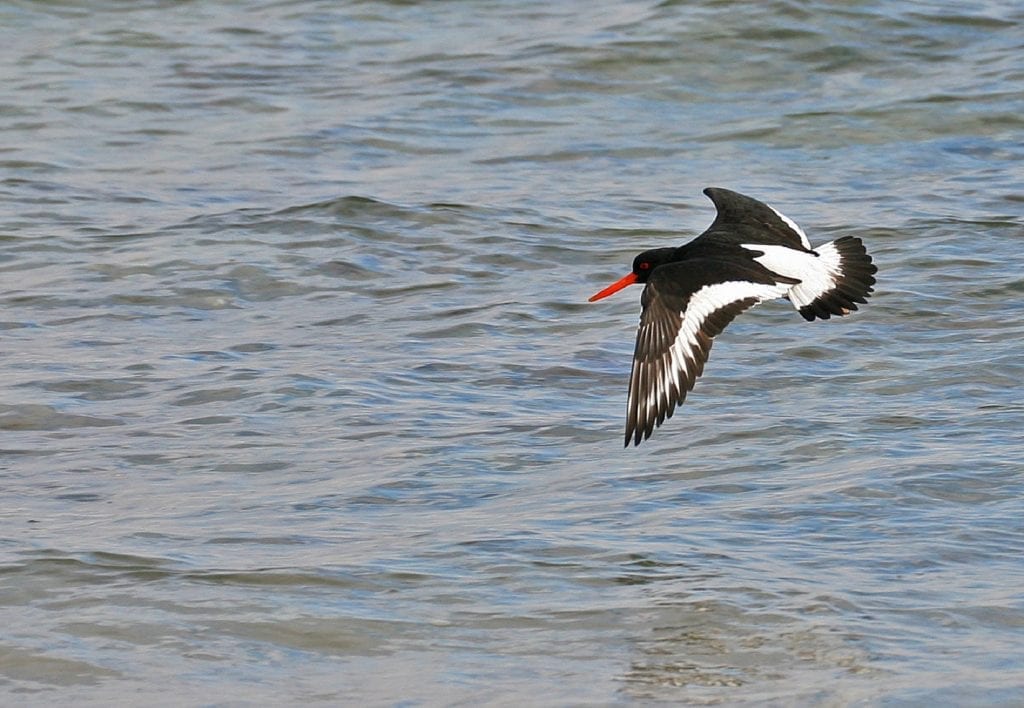 Oystercatcher in flight. (Kevin Murphy).
Oystercatcher in flight. (Kevin Murphy).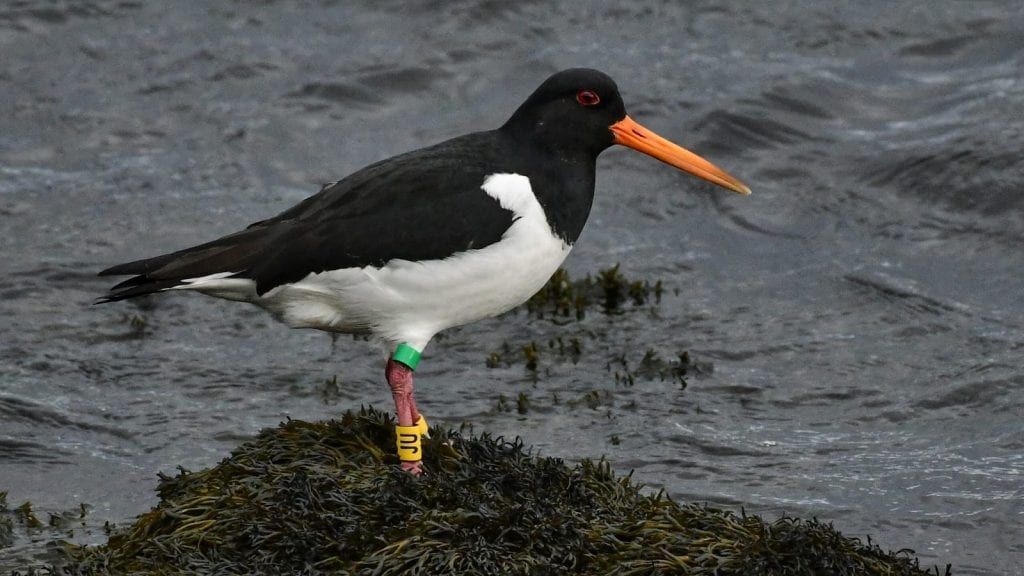 Oystercatcher ‘JU’ on the Isle of Bute, Scotland in April 2019. (Ian Hopkins).
Oystercatcher ‘JU’ on the Isle of Bute, Scotland in April 2019. (Ian Hopkins). 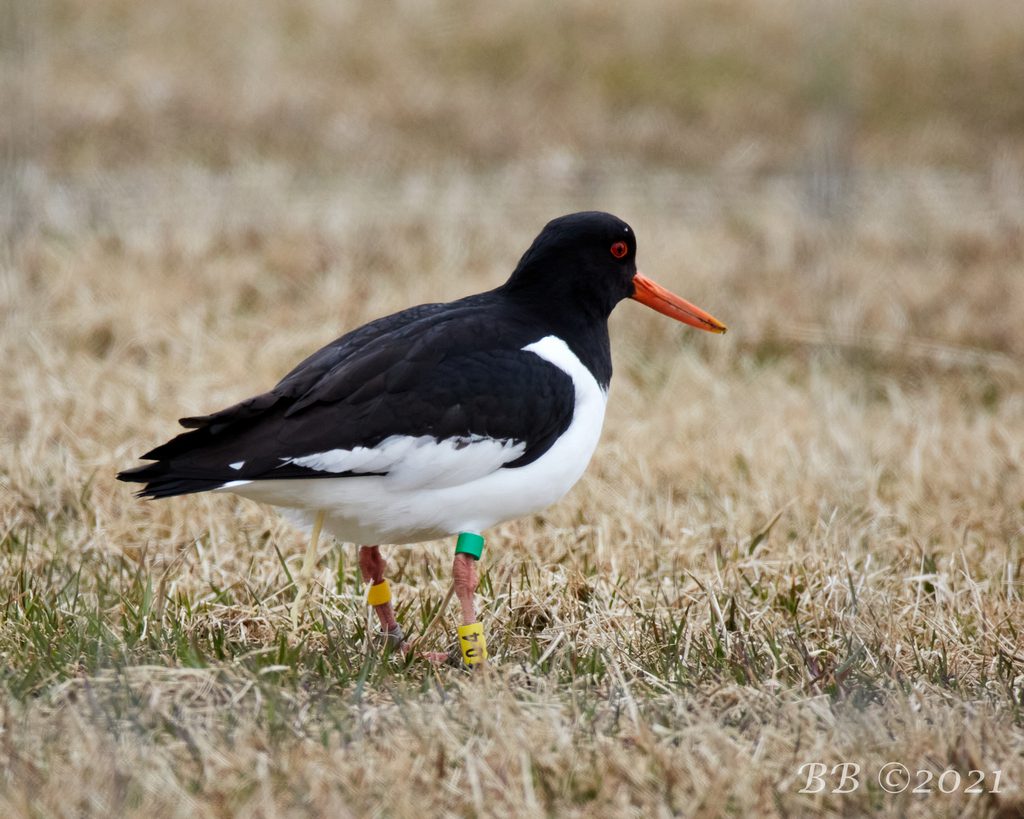 Oystercatcher ’04’ at Engjabakki, Eskifjörður, Iceland in March 2021. (Baldwin Baldwinsson).
Oystercatcher ’04’ at Engjabakki, Eskifjörður, Iceland in March 2021. (Baldwin Baldwinsson).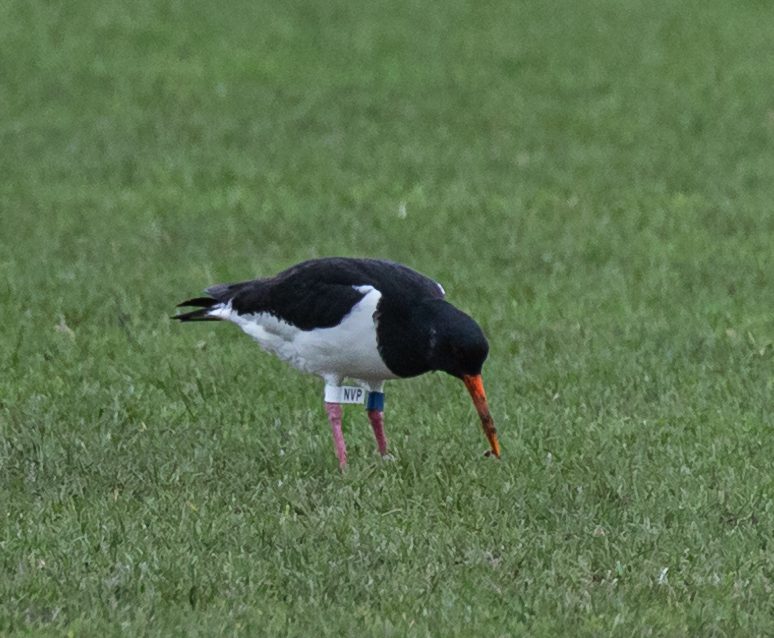 Oystercatcher ‘NVP’. Note the blue uninscribed ring on the left tibia (upper leg). (John Fox).
Oystercatcher ‘NVP’. Note the blue uninscribed ring on the left tibia (upper leg). (John Fox).